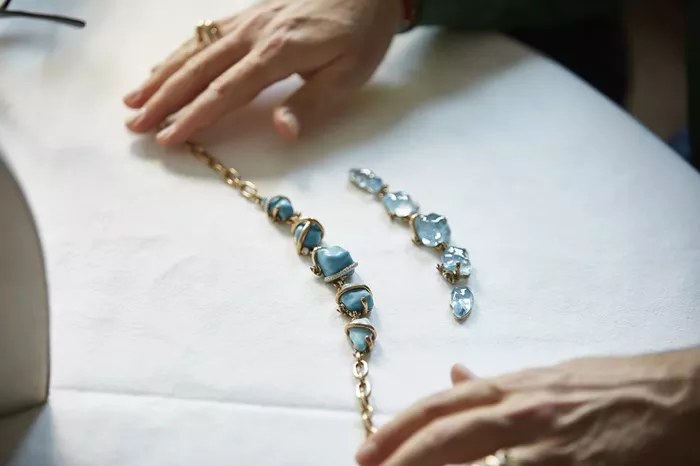For decades, the jewelry world followed strict rules. Stones were judged by clarity, cut, and shine. A diamond labeled “IF Type IIa” — meaning internally flawless under 10x magnification — was seen as the gold standard. Precision and sparkle defined a gem’s worth.
But things are changing.
Today, many jewelers are shifting away from perfection. Stones once dismissed as too dark, too flawed, or too unusual are now being celebrated. These “imperfect” gems, with their quirks and inclusions, are stepping into the spotlight.
Pomellato Leads the Way
Pomellato, the Milan-based jeweler, was one of the first major brands to embrace this trend. Five years ago, it launched a high jewelry collection that broke away from the traditional “big four” gems — diamonds, rubies, sapphires, and emeralds. Instead, Pomellato showcased stones that often don’t sparkle — and some that aren’t even cut.
This bold approach has become central to Pomellato’s identity. In a market filled with luxury names like Dior, Louis Vuitton, Gucci, and Dolce & Gabbana, the brand is carving out a unique space. One of its recent pieces features smooth, unfaceted aquamarines. Their shapes appear naturally sculpted, like pebbles from the sea, and are crossed with diamond threads resembling sailors’ ropes. Another necklace, inspired by the night sky over Milan, features a smoky star made from grey sapphires and spinels.
“At Pomellato, we don’t separate gemstones into ‘precious’ or ‘semi-precious’,” said Stefano Cortecci, the company’s gem master. “We don’t judge them by price. We focus on each stone’s identity and beauty. How it is used and cut is what matters most.”
Cortecci, a trained geologist from a family of academics, joined Pomellato nearly 20 years ago. He brought a different perspective. Instead of buying only polished, traditional gems, he began choosing raw stones. He worked closely with creative director Vincenzo Castaldo to shape them in new, unexpected ways.
“In most jewelry, symmetry is everything,” Cortecci said. “A diamond usually has 57 perfectly cut facets. But at Pomellato, our signature gem, the ‘Nudo,’ also has 57 facets — only they’re not symmetrical. They’re random. The effect is entirely different.”
Finding Beauty in the Unusual
Brazilian jeweler Ara Vartanian also champions non-traditional stones. He is best known for using upside-down black diamonds — with the pointed side facing up instead of the flat, polished top.
“Inclusions never seemed like flaws to me,” he told CNN. Inclusions are materials trapped inside a gem during its formation. Vartanian, who grew up in a family of gem dealers, was drawn to the stones most people ignored — the ones set aside as imperfect.
When he started his own brand about 20 years ago, choosing flawed or black diamonds was also practical. They cost less. But for him, it wasn’t just about price.
“My father thought I was rebelling when I chose black diamonds and set them point-up,” Vartanian said. “But I loved them. I thought they were beautiful. And soon my clients felt the same way. They liked that it was different.”
New Voices, New Stories
Younger designers are also embracing unusual stones. Many of them see these gems as symbols with deeper meaning.
Belgian designer Dries Criel uses tiger’s eye — a stone with rich brown tones — in his bold creations. One of his standout pieces is a scarab-shaped ring. “Tiger’s eye represents protection, courage, and vision,” he told CNN. “For me, it became a symbol of empowerment.”
British label Anoona built its Lunar collection around moonstone, known for its soft, moonlight-like glow. Ananya Malhotra, founder of the jewelry brand Ananya, believes gems can have healing energy. Her designs often include Sulemani Aqeeq, a brown agate believed to bring balance and joy.
Swiss jeweler Cora Sheibani recently used smoky quartz in her newest line. “It’s the overlooked cousin of amethyst and citrine,” she joked. In Milan, Villa Milano experiments with tourmalinated quartz — clear crystal with dark streaks — and even volcanic stones in earrings and cufflinks.
A Shift in Buying Habits
The rise of “imperfect” gems reflects a wider change in who buys jewelry and why.
More women now buy jewelry for themselves. They are drawn to design and meaning rather than just the value of the stone. This marks a shift from male buyers, who often focus on investment or gift-giving.
At Pomellato, 70% of customers are women, according to Cortecci.
“People want something unique,” said Claudia D’Arpizio, a luxury expert at Bain & Company. She said lab-grown diamonds — which are flawless and uniform — are also driving this shift. In contrast, natural stones with imperfections are becoming more desirable because they are rare.
Traditional gem sourcing is also getting harder. Sanctions on Russian diamonds and rising global competition have made high-quality stones harder to find. Using lesser-known or imperfect gems helps brands stay creative and manage costs, D’Arpizio explained. “Gold prices are high. Jewelry isn’t easy to scale. These unique stones let brands create standout pieces without huge material expenses.”
Redefining Perfection
For Hemmerle, a family-run jeweler in Munich, perfection has never meant sparkle. The brand often works with diamonds in unexpected colors.
“Diamonds don’t need to shine,” said Christian Hemmerle, who now runs the company with his wife Yasmin. “They need to speak. If the color is beautiful, that’s enough — even with inclusions. After all, no one looks at a gem through a microscope in daily life.”
Related topics:
- Zodori Studio Launches New Jewelry Collection Inspired by Culture and Nature
- Bulgari’s New High Jewellery Collection Brings More Than Just Large Gems
- Guelph Jewelry Store Hit by Thieves Again


